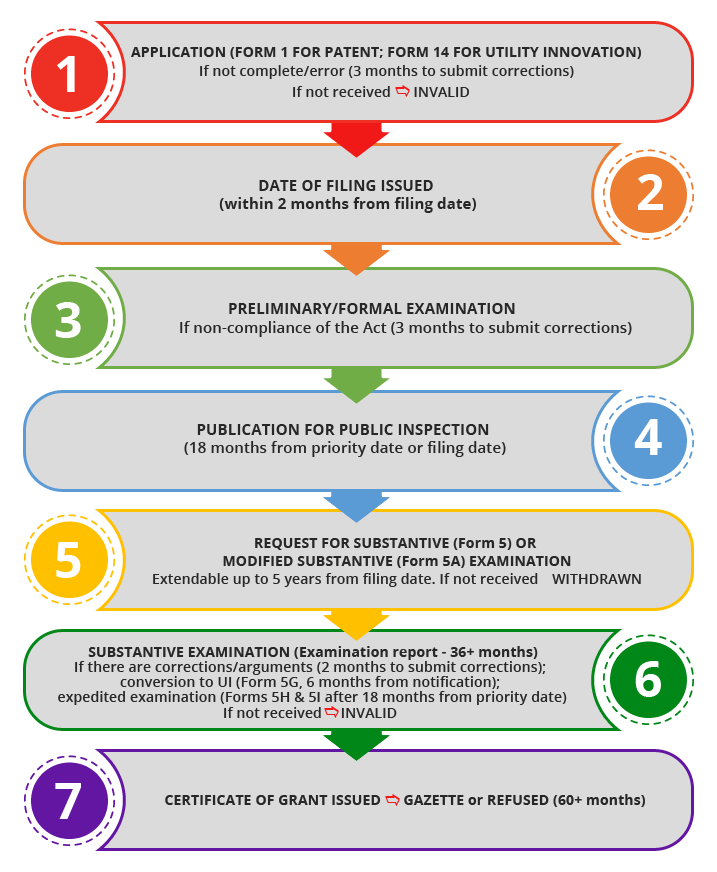Patent
Patent Introduction
Home > Expertise > Patent > Patent Introduction

What is Patent
A patent is a government authority or license conferring a right or title for a set period, especially the sole right to exclude others from making, using, or selling an invention.
What is a certificate for utility innovation (petty patent)?
A utility innovation is an exclusive right granted for a “minor” invention which does not require to satisfy the test of inventiveness as required of a patent.
What is an invention?
An invention is something, typically a process or device, that has been created out of creative and/or innovative ability, and:
- should not be merely abstract or intellectual
- should be of technical character
What invention is patentable?
A product and/or method that is:
- New (novel, i.e. the invention has not been publicly disclosed anywhere else legitimately more than one year prior to the filing for a patent)
- Inventive (the special feature(s) of the invention cannot be obviously derived by any person skilled in the art in view of the common knowledge in the field of the invention)
*Inventiveness is not required for the registration of utility innovation - Industrially applicable (i.e. the invention can be made or used in an industry)
What invention is non-patentable? Is there any exception?
An invention is not patentable if it belongs to any of the following categories:
| Non-patentable Invention | Exception | Example of Exception |
|
Practical applications of the theories or methods that are distinguishable from other known products of the same kind |
Physical theory of electricity → unpatentable; New electrical devices and processes to manufacture these devices → may be patentable |
|
Depends on the extent to which there is technical intervention by man in the process If intervention significantly determines or controls the result it is desired to achieve – NOT essentially biological → patentable |
Process of treating a plant or animal (e.g. pruning a tree, or applying a growth-stimulating substance or radiation) to improve its properties or yield or to promote or suppress its growth – NOT essentially biological → patentable (although involves a biological process, the essence of the invention is technical) |
|
Apparatus for playing a game or carrying out a scheme may be patentable | |
|
|
|
|
|
Programme-controlled internal working of a known computer |
What is the use of patent?
A patent owner has the right to:
- prevent others from using it,
- abandon it,
- sell it,
- assign it for a fee or free, and allow one or many others to use it, while retaining its ownership
What is the limitation of my rights as a patent owner?
The rights under a patent shall not extend to acts:
- done only for scientific research
- done for uses reasonably related to the development and submission of information to the relevant authority which regulates the manufacture,
– the owner of the patent,
– a person who was in good faith in Malaysia making the product or using the process, or made serious preparations towards the making of the product or using the process which is the subject of the invention claimed in the application provided that it is proved that his knowledge of the invention was not a result of prior disclosure of the claimed invention;
– done by the licensee or beneficiary of compulsory license as stipulated in the license contract - using the patented invention on any foreign vessel, aircraft, spacecraft or land vehicle temporarily in Malaysia
- done outside the duration granted for a patent or when a patent has lapsed as specified by law
Why do you need a patent for an invention?
- Gives a competitive edge, improve market power
- Protects when invention is disclosed publicly
- May eliminate competition
- Add revenues by licensing a patent
- Raise funds, attract investors
- Patents may be bought, sold or licensed, or serve as collateral for bank loans
- Protect R&D investments and improve the return on your investments
- More assured to have some type of market barrier for competitors
- Most investors recognize the value of a patent
- A bargaining chip during licensing negotiations with a competitor or when accused of patent infringement
- Defend against your competitor’s patent portfolio
- Improves your freedom to operate in the marketplace
- A tradable asset, which can be sold
- Prevent others from stealing your idea
- Value for entering new markets
- Strategic partnerships
- Mergers and acquisitions
- Good initial public offering (IPO) for listing on the stock exchange
- Higher sale price of an established company
- Convoyed sales – when a customer is attracted by a patented improvement of a product, sales of related non‐patented articles may increase
- Allows recognition or reward to your inventor‐employees
- Supports advertising, marketing and branding strategies – shows higher technological and innovative capabilities and superior performance
Under which law is a patent protected in Malaysia?
In Malaysia, a patent is protected under the Patents Act 1983. All procedures relating to patent applications and executions are regulated under the Patents Regulations 1986.
Why is patent registration important?
The owner of a patent can exploit the patented invention, assign or transmit the patent, and/or conclude license contracts relating to the use or production of the patented invention.
What is the duration of protection for a patent and a certificate of utility innovation?
- Patent – maximum of 20 years from the date of filing subject to annual renewal from the second year after the grant of patent (with annual renewal fees).
- Certificate of utility innovation – maximum of 10 years (extendable 5 years + another 5 years) from the date of filing subject to annual renewal from the third year after the grant of certificate (with annual renewal fees).
Who may apply for a patent?
Any person, either alone or jointly with another person – not limited to only natural persons and also includes, for example, a company.
What action can be taken if a patent is infringed or about to be infringed?
If the owner of the patent proves that an infringement has been committed or is being committed, the case can be brought to a High Court. The Court shall award damages and shall grant an injunction to prevent further infringement and any other legal remedy. If the owner of the patent proves that an infringement is about to be committed, the Court shall grant an injunction to prevent infringement and any other legal remedy.
Note: This section contains adaptations of articles from WIPO, MyIPO and Malaysian Patents Act 1983. The materials published in this section are for educational purposes only.
All You Need To Know About Patent Application
Under which law is a patent protected in Malaysia?
- Patent specification, i.e. the documents specifying the details or your invention, which include:
- title;
- technical field of the invention;
- background of the invention;
- summary of the invention;
- brief description of the drawing(s);
- detailed description of the invention;
- claim(s);
- abstract; and
- illustration/drawing(s) relevant to the invention
- Relevant form(s) – refer to section “Application processes.”
- Payment of application fee(s) – refer to section “Application processes.”
Application Process
1. Filling for a patent locally (in Malaysia)
The timeline (typical) and forms:

2. Filing for a patent internationally (2 options):
- via Patent Cooperation Treaty (PCT) routeThe timeline (typical) and forms:

Advantages of international filing via PCT:- PCT formalities requirements are checked
- International publication may replace national publication
- International search report available
- International preliminary report on patentability available
- Priority period extended to 30 months before entry into national phase – extra time for consideration after reviewing reports from International Search Authority
- via individual national routes (without PCT)
Applicant replicates documents and file individually (direct) in countries where applicant seeks protection. The procedures, timelines and fees vary from country to country.
Why do I need a patent agent?
A patent agent provides expertise in:
- Conducting patent/novelty search
- identify newness and special features of invention which are patentable
- Consulting on patentability of invention and the application procedures
- ensures nothing is overlooked or unaware of
- Drafting patent specification (with careful wordings and terminologies)
- drafting is time-consuming and complex process
- complies with requirements of the Act and ensures sufficient protection of claims
- understands applicable examiner and court decisions
- Responding to examiner’s reports/objections
- experienced in communicating with patent offices and examiners
- Following up on deadlines and application status
- worry not about keeping multiple portfolios in check
- Representing applicant in all correspondence
- having an agent acting on your behalf keeps you hassle-free

